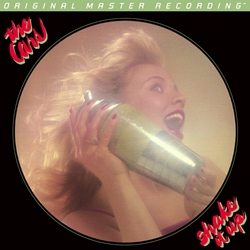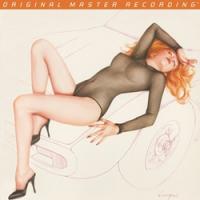The Cars Get Mo-Fi Drive: Candy-O and Shake It Up
As it turns out, The Cars were just what another million music fans needed too. Recorded at London’s AIR studios, their debut record was so fresh and appealing that it instantly became an AM radio favorite and went Platinum in six months.
The Boston-based band jokingly referred to their eponymous record as The Cars Greatest Hits Michael Fremer's review. But Ric Ocasek wasn’t done yet. As the band’s principal songwriter, lead vocalist, rhythm guitarist, and the son of a Polish NASA computer analyst, Ocasek had a quirky style, unique voice, and undeniable pop party sensibility. He would soon go on to craft album after album of toe-tapping songs that pleased both rockers and top 40 fans.
The band’s musicianship was memorable yet controlled. Elliot Easton's economic guitar riffs were subtly tasteful but hard to get out of your head. Greg Hawkes’ muti-layered synth keyboard playing was equally innovative and subdued. And the late Ben Orr was brilliantly tuneful on bass. Finally, David Robinson’s mechanically perfect drum fills complemented and sustained the strong groove. This was New Wave done right.
When the follow-up Candy-O arrived in June 1979, The Cars were still firing on all cylinders. Hitting the airwaves at full stride, it proved to be no sophomore slump. More evolutionary than revolutionary, it was a bit darker, with lyrics still full of cool irony, and just as needed.
Hook-laden anthems like the energetic “Let’s Go”, “It’s All I Can Do”, “Night Spots”, “Candy-O”, and the sublimely inspired “The Dangerous Type” all proved essential for the times. The album became an instant Platinum winner. It seemed that everybody liked The Cars.
After their experimental art album, Panorama, The Cars went back to basics with the synth-pop Shake It Up in 1981. This was their last album produced by Roy Thomas Baker and the one that gave them their first billboard top ten hit (with the catchy title track). It’s little wonder MoFi decided to reissue these perennial favorites in addition to the debut. True to their reputation, the boys in Sebastopol have remastered these classic albums with overall improvements in instrumental separation, extension, and sound staging.
The late George Marino originally mastered Candy-OShake It Up at Sterling Sound in New York. The dead wax on these original LPs reveals both “Sterling” and producer “RTB”, and on Candy-O (catalog 5E-507) there is a scratched out “6E-111”, which was the 1977 reissue number for Judy Collins' Judith LP! U.S. Elektra pressings of these albums can often sound very good, especially Shake It Up, but on Candy-O many cuts are a bit hard with limited dynamics.
On the MoFi version these issues are pretty much a thing of the past. Dynamics are much improved on Candy-O, being consistently punchy and engaging. Drums in particular are rendered with greater realism, especially when you consider the already “larger than life“ inherent production values. Thankfully the cymbals are reproduced cleanly without being overly bright.
The new mastering also provides better treble and bass extension, along with a wider and deeper soundstage. Heck, there is even some space around Ocasek’s vocals. Background instrumentals are also better separated in the mix.
Easton's power chords are reproduced with superb resolution, with his overdriven guitar sound having just the right amount of rich crunchy distortion and plenty of snap. Bass is deep and well controlled, being especially improved on Candy-O, an album recorded at Cherokee Studios in Los Angeles. Hawkes’ intricate synthesizer floats serenely above it all.
 On the MFSL vinyl of Shake It Up, the results are a bit more mixed. This pressing is cut significantly lower in volume than the US original. Consequently, some will find that perceived dynamics have been reduced. The up side is that much of this album, which was recorded at Syncro Sound in Boston, is improved on the newer pressing. The original, while snappier, bangs away like a relentless metronome – becoming incessantly glossy and clinically robotic.
On the MFSL vinyl of Shake It Up, the results are a bit more mixed. This pressing is cut significantly lower in volume than the US original. Consequently, some will find that perceived dynamics have been reduced. The up side is that much of this album, which was recorded at Syncro Sound in Boston, is improved on the newer pressing. The original, while snappier, bangs away like a relentless metronome – becoming incessantly glossy and clinically robotic.
The MFSL reissue is arguably easier to listen to because of newfound warmth and smoothness that’s set on a larger soundstage. It’s important to note that neither of these recordings is ever going to be considered that realistic sounding. But what is available here on the MoFi vinyl is a very convincing presentation of the band’s music.
Alberto Vargas of Playboy fame illustrated Candy-O, and MoFi chose to use the original U.S. version of the cover sans band name or printed title as the group intended. Unfortunately, the original nifty inner sleeve is absent. Vargas had retired by ’79 but was persuaded to take the job by his niece, who was a fan of the band. The model was Candy Moore (from The Lucy Show), who reportedly dated drummer Robinson at the time.
On Shake It Up, the late Natalya Medvedeva graces the cover, as she did on the debut album. Here, MoFi reproduced the original’s lyric/photo inner on the inside of a beautiful gatefold jacket. Wonder why this wasn’t done with Candy-O? Along with exquisite covers, my copies of the 180-gram reissues had flat and silent RTI pressed surfaces. Also available from Mobile Fidelity are gold CDs of theses two titles.
When you consider how brief the run was for New Wave music (and the associated mullet hairdos), these albums still sound fresh and inviting today. So, drop the top, put the MoFi CDs into the player, and cruise into the sunset. Are these tunes essential? I don’t know, but they sure are fun to listen to. Beep, beep. Let’s go!




